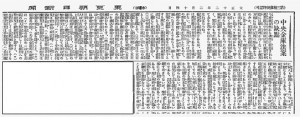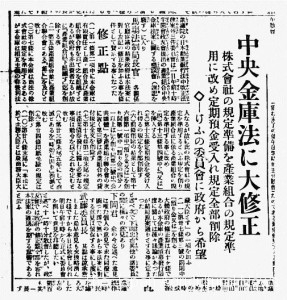Jockeying between the two Ministries
Executives of the sangyokumiai early had felt the need for a central financial institution. In 1891 (Meiji 24), Tosuke Hirata also took up it in “Shinyokumiai (credit cooperatives) theory.” Hirata and Yajiro Shinagawa introduced the German central bank of cooperatives in “Shinyokumiai Teiyo (Essence of credit cooperatives) “, and claimed “Our country sooner or later needs it.”
Hisayoshi Kano, vice president of Dainihon sangyokumiaichuokai, made a speech to demand the establishment of central financial institution at the second national congress of sangyokumiai in May 1903 (Meiji). Since then, the congress continued to resolve the demand of its establishment.
Since 1921 (Taisho 9) when the recoil depression after World War I gave a big blow to the rural economy, peasant dispute occurred in various regions, the establishment of central bank of sangyokumiai (cooperatives) became to be required even more compelling. Regarding sangyokumiai (cooperatives)-related financial institutions, three special banks had been established before and after of the year1900 (Meiji 33) when sangyokumiai law was enacted. They were Nippon Kangyo Bank (Japan Kangyo Bank, currently Mizuho Bank), Noko bank (agricultural and industrial bank) (merged with Nippon Kangyo Bank after), Hokkaido Takushoku Bank (became bankruptcy, and its business was transferred to the Hokuyo bank and Chuo Mitsui Trust and Banking Company, Limited). All three lines of banks aimed for providing financial functions to small producers of agriculture and industry. it has been the primary purpose of achieving the financial valve. Hokkaido Takushoku Bank also played the role of Noko bank of Hokkaido, was also able to lend money to key industries.
Ministry of Finance agreed to draft of the Ministry of Agriculture and Commerce
However, the laws for Kangyo Bank and Noko bank were also amended in 1911 (Meiji 44), so that the loan purpose restriction on both of banks was removed. As a result, character of both banks became real estate bank and far from the original purpose.
On the other hand, within the Ministry of Finance, the merger issue of the two banks was discussed. At the same time, the Ministry of Finance had been kneading the draft of establishment of ” central bank for sangyokumiai (cooperatives) “.
Sangyokumiaichuokai also created a committee, and went into specific consideration towards the establishment. The debate was incandescent regarding the procurement of capital, whose amount was 30 million yen. The point of discussion was that whether the investment should be full government, or it should be a joint venture of the government and the cooperatives.
Joint investment advocates faction claimed the autonomy of sangyokumiai. On the other hand, wholly government-funded advocates faction focused on emphasis on stability of management. For even the name, there were 2 types of drafts, “sangyokumiaichuoginko (central commercial bank for cooperatives)” and “sangyokumiaichuokinko (Central cooperatives Bank for cooperatives)”. Sangyokumiaichuokai thought whichever was good because it was real intention.
On February 3, 1924 (Taisho 12), sangyokumiaichuokai issued a proposal document of the “establishment of sangyokumiaichuokinko (central cooperative bank for cooperatives)” to the government. A week later, by the member of congress of Seiyukai party, “sangyokumiaichuoginko (central commercial bank for cooperatives) bill” was submitted to the Imperial Diet along the intention of Ministry of Finance.
Ministry of Agriculture and Commerce was said to have surprised that the Ministry of Finance and Seiyukai party rapidly acted. the Ministry of Agriculture and Commerce was opposed to the central commercial bank bill by Ministry of Finance, and hurriedly submitted the “sangyokumiaichuokinko (central cooperative bank for cooperatives) bill”.
The reason that the Ministry of Finance urged to “commercial bank” was that the central financial institution of sangyokumiai should be under the jurisdiction of the Ministry of Finance although sangyokumiai was under the jurisdiction of the Ministry of Agriculture and Commerce.
Bureaucrats of Ministry of Agriculture and Commerce claimed, “The draft of kinko (cooperative bank) aims for purely mutual systematic organization, so that it does not disturb the ginko (commercial bank) system,” and started to persuade the Ministry of Finance. There was also opposition by Japan Kangyo Bank, so that Ministry of Finance issued an amendment to reduce the scope of work of central kinko (cooperatives bank) as follows; 1) Prohibition of deposits from the public, ② Prohibition of dealing with government bonds and public debenture, at last agreed in draft of central kinko (cooperative bank).
Thus, the sangyokumiaichuokinko (central cooperative bank for cooperatives) bill, which was the cherished desire of sangyokumiai (cooperatives) world, passed through both Diet on March 24, 1924 (Taisho 12), and was promulgated on April 5.
◇

The Tokyo Asahi newspaper on February 14, 1923 (Taisho 12) (above) posting a commentary article titled “disadvantages of the Central Bank bill”
Newspaper tone on chuokinko (central cooperative bank) law generally had criticism and negative theory. “Tokyo Asahi Shimbun” set a commentary article titled “The disadvantage of kinko (cooperative bank)”, which criticized and cited the shortcomings such as “there is no direct relationship between kinko (cooperative bank) and sangyokumiai (cooperatives),” or “Its board members are government-appointed. ”
On the other hand, editorial of “Hochi Shimbun” (at the time the general paper) praised that “Phenomenon to be pleased for rural development,” while criticizing government half-owned structure and
government-appointed board members. “Toyokeizaishinpo” also said, “one of the causes of the rural poor is financial difficulties,” and “ability of current shinyokumiai (credit cooperatives) is poor, so that the establishment of the central cooperatives bank is necessary.” (History of sangyokumiaichuokinko (central cooperative bank for cooperatives)).


